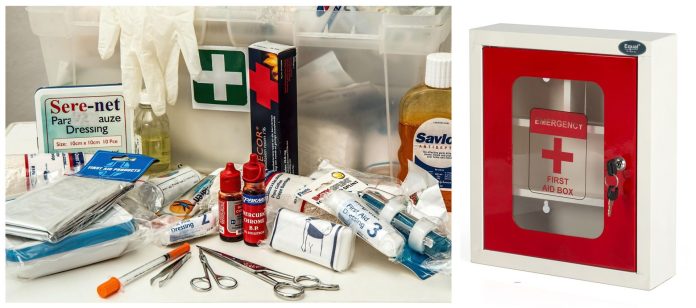A well-equipped first aid kit is essential for addressing minor injuries and medical emergencies at home. While the specific contents of a first aid kit can vary depending on personal needs and preferences, here is a list of items that are commonly recommended for a basic home first aid kit:

PC: IBX
- Adhesive bandages (assorted sizes): These are used to cover and protect small cuts, blisters, or abrasions.
- Sterile gauze pads and adhesive tape: Used for larger wounds or to help stop bleeding.
- Antiseptic wipes or solution: Used to clean wounds and prevent infection.
- Scissors and tweezers: For cutting tape, clothing, or removing splinters.
- Disposable gloves: To protect yourself from bodily fluids and to prevent contamination.
- Thermometer: To check for fever or elevated body temperature.
- Pain relievers: Over-the-counter pain medications like acetaminophen (Tylenol) or ibuprofen (Advil) for pain and fever.
- Tweezers: For removing splinters or foreign objects from the skin.
- CPR face shield or mask: For performing CPR safely.
- Instant cold packs: To reduce swelling and pain from injuries.
- Elastic bandages (like Ace bandages): Used for wrapping sprains and strains.
- Tweezers and scissors: For removing splinters, cutting tape, or clothing.
- Disposable instant hand warmers: Useful for treating hypothermia or keeping hands warm in cold weather.
- Sterile saline solution: For cleaning wounds and rinsing eyes.
- A notepad and pen: Document important information, like allergies or medical history.
- Emergency contact numbers and a first aid manual: In case you need guidance on administering first aid.
- Personal medications and medical supplies: If someone in your household has specific medical conditions, ensure their medications and supplies are readily accessible.

PC: HealthCentral
Additionally, consider your family member’s special needs or medical conditions when customizing your first aid kit. For example, if you have children, you may want to include child-specific medications and items like baby wipes or children’s bandages.
It’s essential to regularly check the contents of your first aid kit to ensure that items are not expired, and replace any used or outdated items. Also, make sure your first aid kit is easily accessible and that all family members know its location and how to use its contents in case of an emergency.






